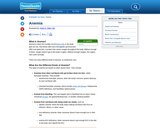
Students learn about the causes, symptoms, and treatments for anemia.
- Provider:
- KidsHealth
- Author:
- The Nemours Foundation
- Date Added:
- 06/24/2019

Students learn about the causes, symptoms, and treatments for anemia.
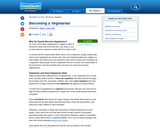
Students learn the ins and outs of becoming a vegetarian and staying healthy. The following topics are covered: ?Why Do People Become Vegetarians? ?Vegetarian and Semi-Vegetarian Diets ?Are These Diets OK for Teens? ?Iron ?Calcium ?Vitamin D ?Protein ?Vitamin B12 ?Zinc ?Fat, Calories, and Fiber ?Getting Some Guidance ?Tips for Dining Out
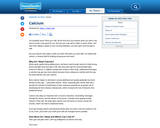
Students learn all the benefits of calcium for teens.You probably heard "drink your milk" all the time from your parents when you were a kid, and you knew it was good for you. But now you may opt for sodas or sports drinks, and other than adding a splash to your morning Wheaties, you don't give much thought to milk. But your parents were right to make you drink milk when you were little. It's loaded with calcium, a mineral vital for building strong bones and teeth.

In this lesson students will recognize the importance of eating a variety of foods for snacks.
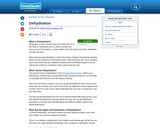
Students learn about dehydration and the following topics: ?What Is Dehydration? ?Causes of Dehydration ?Signs of Dehydration ?Preventing Dehydration ?When to See a Doctor

Calcium, the most abundant mineral in the body, is found in some foods, added to others, available as a dietary supplement, and present in some medicines (such as antacids). Calcium is required for vascular contraction and vasodilation, muscle function, nerve transmission, intracellular signaling and hormonal secretion, though less than 1% of total body calcium is needed to support these critical metabolic functions. This resource provides facts about calcium.
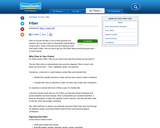
Students learn why fiber is your friend and how to include it in your diet. Most of us know that fiber is one of those good-for-you nutrients. But you don't have to eat gravelly, tooth-breaking cereal to get it. Some of the best and most delicious foods have loads of fiber. Find out how to get your fill of fiber without sacrificing good taste ? or tooth enamel!

Students explore the concepts and content necessary to debate whether or not schools should regulate the quantity or type of food and beverages students consume, and develop position papers.

Students will investigate food in countries in different parts of the world. They will investigate the history, geography, and tradition that impact the food the people eat. Is there a certain reliance on a certain nutrient due to history, geography, and/or tradition? This lesson was developed by Matthew Cline as part of their completion of the North Carolina Global Educator Digital Badge program. This lesson plan has been vetted at the local and state level for standards alignment, Global Education focus, and content accuracy.

Today students will look at Food Labels. Food Labels are required by many countries to be visible on manufactured/processed/prepared foods. Are some food labels better than others? What nutrients should be most visible on food labels Should some nutrients not be as important in a food label? This lesson was developed by Matthew Cline as part of their completion of the North Carolina Global Educator Digital Badge program. This lesson plan has been vetted at the local and state level for standards alignment, Global Education focus, and content accuracy.

Students will investigate what McDonald’s offers in restaurants in different countries. In the United States, students will be familiar with the Big Mac, Double Cheeseburger, and Egg McMuffin. Students may believe that McDonald’s would not offer more menu choices. Through investigation, students will see what else McDonald’s offers. 8.NPA.1.2 Summarize the benefit of consuming adequate amounts of vitamins A, E, and C, magnesium, calcium, iron, fiber, folic acid, and water in a variety of foods. 8.NPA.3.1 Identify media and peer pressures that result in unhealthy weight control (eating disorders, fad dieting, excessive exercise, smoking). This lesson was developed by Matthew Cline as part of their completion of the North Carolina Global Educator Digital Badge program. This lesson plan has been vetted at the local and state level for standards alignment, Global Education focus, and content accuracy.
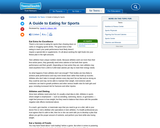
Students learn how to eat when playing sports including eating extra for excellence and choosing a variety of foods.

In this lesson students will identify a variety of healthy foods.

Students will identify the nutritional benefits of fruits and vegetables.
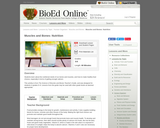
In this lesson, students learn about the nutritional needs of our bones and muscles, and how to make healthy food choices, especially in terms of getting enough calcium.

Students will identify grains and whole grain foods and analyze their diet to see if they are consuming the recommended amounts of grains and whole grains daily.
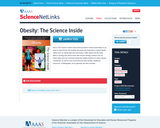
Part of The Science Inside series, this easy-to-read booklet discusses the importance of good health habits such as eating right and exercising. 77 pages

In this lesson students will recognize a variety of healthy foods.

This article provides information concerning the functions of water within the body, food sources for water, and the side effects of not drinking enough water.
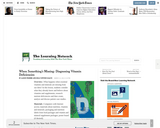
Students consider what they already know and believe about vitamins and supplements, research nutrient deficiencies and then create, analyze and discuss patient case studies.